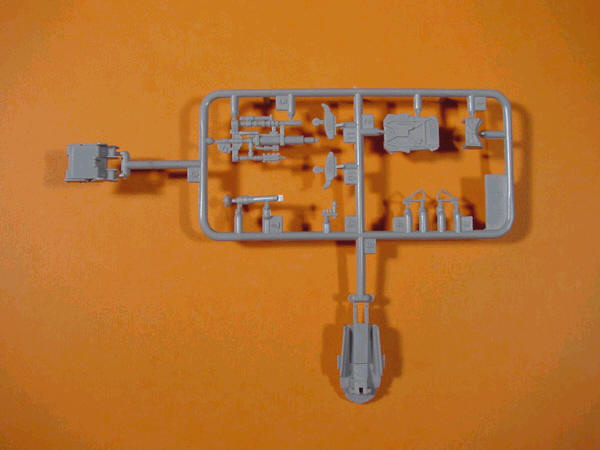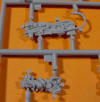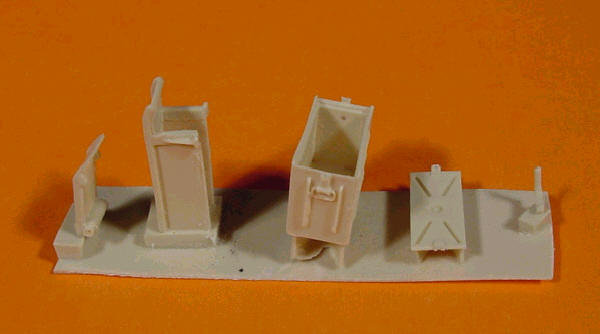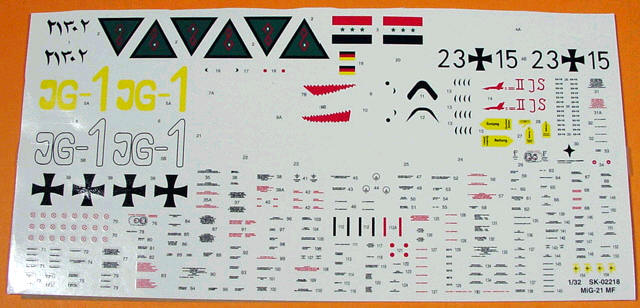|
MiG-21MF
Fishbed J

Trumpeter
S
u m m a r y
|
| Catalogue Number
and Description: |
02218 |
| Scale: |
1/32 |
| Price: |
USD$59.95 |
| Contents and Media: |
322 plastic parts, 1 acetate sheet
(instruments), 4 resin parts, 4 metal parts, 3 vinyl tires, 6 screws
|
| Review Type: |
First Look |
| Advantages: |
Generally good surface detail,
various weapons options, good cockpit detail |
| Disadvantages: |
Poor molding on rocket pods, soft
detail on parts of engine, poor registration on some decals |
| Recommendation: |
Recommended |
Reviewed by Dave
Williams

Trumpeter's 1/32 scale MiG-21MF is available online from Squadron.com
For those in the market for a large scale Fishbed, Trumpeter has answered the
call.
The only injection molded choice until now has been the ancient Revell
offering. This kit started life as a –PF and later had some new parts thrown in
for release as a –MF. The Revell kit can go back in the closet or get put up on
eBay as the Trumpeter kit is superior to the older kit in almost every respect.
General
Description
Surface detail is recessed and, although not quite up to Tamiya or new Revell
quality, is pretty good. The kit features the option of displaying the rear
fuselage on a trolley to allow viewing of the engine. The nose avionics bay
hatch can be displayed in the open position. The landing gear is done in metal
to support the weight of the model and vinyl tires are provided, although the
tread pattern seems suspect.
 The
center shock cone is supplied in metal to help weight the nose, although a
plastic cone also exists on the sprues (click
thumbnail to left to view larger image). The
center shock cone is supplied in metal to help weight the nose, although a
plastic cone also exists on the sprues (click
thumbnail to left to view larger image).
Each wheel well is formed of multiple parts to increase the level of detail
over what you would get with a single piece part. The right and left fuselage
wheel wells are correct in having different internal details and, in case anyone
is wondering, Trumpeter got the position of the wheel bulges on the upper
fuselage sides right. The five spheres inside the wing wheel wells are provided,
although the painting instructions are incorrect. Only the three center oxygen
spheres should be painted blue, while the pressurized air spheres at either end
should be painted black.
All the control surfaces are separate parts. The flaps have tabs to fit them
in the lowered position and the horizontal stabs are designed to be movable.
However, photographs almost invariably show parked MiG-21s with flaps up,
ailerons neutral, and the stabs in the horizontal position. In contrast, these
same photos usually show a large amount of rudder deflection on parked aircraft,
so if you want to reposition anything, just do the rudder. Both the spill doors
and suction relief doors on the sides of the nose are separate parts to allow
them to be positioned open, but they are normally closed when the engine is not
running. The speed brakes can also be shown in the open position.
Click thumbnails below to
view larger images:




Cockpit and
Interior
Trumpeter's MiG-21 cockpit is a pleasant surprise after the featureless A-10
tub. Both the seat and tub are fairly detailed. While either the Black Box or
Cutting Edge cockpits would be an improvement, the kit cockpit will be quite
acceptable to many modelers.

The instrument panel is done in clear plastic with holes through
the part where the instrument dials go. The rear of the instrument panel has a
recess for the installation of instrument dial detail printed on a clear acetate
sheet, similar to an Eduard PE instrument panel. However, the walls that form
the sides of the recess are fairly thick and seem to encroach on some of the
instruments near the edges of the panel.
 The transparent parts are clear and consist of separate canopy and
windscreen, the instrument panel, underwing landing lights, HUD glass, and
seeker domes for the R-3S missiles. In case anyone is wondering, the part number
for the rear view mirror fairing is A38, as Trumpeter forgot to include it in
the instructions. The windscreen in both my –MF kits have a faint curved line
across the center pane, which does not appear to be a surface scratch and may
indicate a slight flaw in the mold. The line isn’t very obvious, but something
similar appears in the canopies of the A-10 kits I have. The transparent parts are clear and consist of separate canopy and
windscreen, the instrument panel, underwing landing lights, HUD glass, and
seeker domes for the R-3S missiles. In case anyone is wondering, the part number
for the rear view mirror fairing is A38, as Trumpeter forgot to include it in
the instructions. The windscreen in both my –MF kits have a faint curved line
across the center pane, which does not appear to be a surface scratch and may
indicate a slight flaw in the mold. The line isn’t very obvious, but something
similar appears in the canopies of the A-10 kits I have.
As previously mentioned, the kit contains a complete engine and the rear
fuselage can be displayed separately to allow viewing of the engine. Strangely,
Trumpeter has divided the engine into four quarters instead of the more
conventional two halves, which means more seams to fill.
Click thumbnails below to
view larger images:


While the external detail on the afterburner section is nice and crisp, the
detail on the forward half of the engine, which represents a multitude of wires
and hoses, is somewhat soft and out of place with the detail level of rest of
the kit. This softness of detail also extends to some the other parts with hoses
and wires added on to the front of the engine. While a wash and some creative
painting may improve how these parts look, I suspect that many people will just
glue the rear fuselage to the front half. Also, while the exterior of the engine
is detailed, the interior of the tailpipe is smooth and featureless except for
some large ejector pin marks.
Stores and
Ordnance
Five of the sprues in the kit are devoted to the stores options.
Click thumbnails below to
view larger images:



Three 490 liter drop tanks are supplied, plus one 800 liter tank, four R-3S
(AA-2 Atoll) IR missiles, two R-3R SARH missiles, two RS-2US (AA-1 Alkali) radar
beam riding missiles, two FAB-250 bombs, two UB-16-57 rocket pods, and two
UB-32-57 rocket pods.
Although not mentioned in the instructions, there is also an additional pair
of Sidewinder-type missiles on the sprue, which I suspect may be PL-2As used by
the J-7III Chinese copy of the MiG-21MF. The weapons are basically OK, although
the front openings on the rocket pods are notably uneven in size and
fore-and-aft position which essentially makes them unusable, in my opinion.
While the inclusion of the ancient RS-2US missiles on a third generation MiG-21
may at first appear out of place, photos appear to show that RS-2Us on the
inboard pylons and R-3s on the outboard pylons was a fairly common loadout on
Warsaw Pact –MFs assigned to interception duties. Although not many photos show
the missiles actually loaded, the appropriate missile rails for this combination
are usually in place. Countries like Poland and East Germany had previously
operated MiG-19PM interceptors, and therefore had large stocks of the old
missile on hand. As a note when hanging stores, rockets and missiles could be
carried on all four wing pylons, but tanks were normally seen only on the
centerline and outboard positions. At least one 490 liter tank was usually
carried, on the centerline, but the large 800 liter tank was rarely used, except
for ferrying.
The kit includes five figures - a seated pilot and four ground crew members.
One member of the ground crew is shown reloading a packed braking parachute in
the tail bullet, and the other three are molded loading the ammunition for the
belly GSh-23 gun. One man is meant to be positioned on the left wing feeding the
ammo belt into a small hatch just below the spine, while the other two are
kneeling on either side of the gun attaching the belt to the gun breech through
a pair of openings in the lower fuselage.
An ammo box and feeding device are included in resin, and segments of ammo
belt are included on the sprue with the ground crew. The instructions and box
show real pictures of ground crew performing these operations, which should be
of help in setting up your vignette.

As a note, the fuselage hatches associated with the ammo loading operation
are separate parts that are designed to be shown in the open position, however
there is no detail inside the fuselage in these areas. Also, you’ll have to open
up the muzzle area of the GSh-23.
Decals
Decals are provided for an Iraqi bird and a Luftwaffe post-reunification
aircraft from JG-1 painted up with a sharkmouth to commemorate the retirement of
the MiG-21 from Luftwaffe service.

The decals appear thin and glossy, and most of the stenciling data, which is
provided for the JG-1 bird, is quite legible, although I can’t vouch for the
spelling. I did note some registration problems with the Iraqi nation insignia
on my sample, but the rest of the decals seem basically OK.
Conclusion
Overall, a nice kit. Hopefully their upcoming MiG-19 will be as good and they
will continue making modern 1/32 scale aircraft.
Recommended.
Sample kit courtesy of my wallet.
Dave Williams
IPMS/USA 19050
Review Copyright © 2001 by Dave
Williams
Page Created 21 July, 2001
Last updated 22 July, 2003
Back to HyperScale
Main Page
Back to Reviews
Page
|
Home | What's
New | Features
| Gallery |
Reviews | Reference
| Forum
| Search